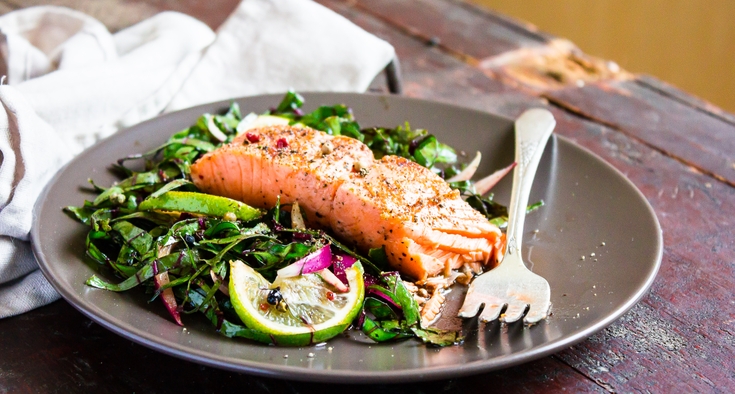More than 1 in 3 American adults – about 98 million people — have prediabetes. And 81% of them don’t know they have it, according to the Center for Disease Control and Prevention (CDC).
Those are sobering statistics, but the good news is that prediabetes is reversible.
People who fall into the prediabetic category should do all they can to prevent developing a disease that puts them at higher risk of heart disease, kidney disease, stroke, vision problems, amputations, severely diminished quality of life – and even death. Being diagnosed with prediabetes is an opportunity for people to rewrite their future.

Joyce Eury, a Novant Health registered dietitian, helps people rewrite their stories – before it’s too late. The condition can be reversed with proper medical care and lifestyle changes like regular exercise. We talked to Eury about the guidance she gives her patients and what others can learn from that.
Prevent, delay, or reverse prediabetes.
Let’s start with a basic definition of prediabetes.
Prediabetes is when your blood sugar is higher than the normal range, which is an A1C less than 5.7%. Blood sugar that ranges from 5.7% to 6.4% is considered slightly elevated or prediabetic. In this range, your body is becoming resistant to insulin, the hormone that pulls glucose out of your blood and into the rest of your body to use as energy.
High glucose levels in the blood can lead to serious health problems. However, in this prediabetes zone, people still have the power to avoid diabetes.
Good to know. And I’m glad you mentioned A1C, which I hear about often these days. Is that the same as blood sugar?
It’s a way to measure blood sugar.
There are a couple of ways your blood sugar can be assessed. A1C is the three-month average of your blood sugar levels. When you check your blood sugar with a finger stick – that reading is just for that particular moment of the blood draw. A1C is a more holistic view.
Once a person falls into the prediabetic category, what can they do to reverse it?
Several things – and it’s all based on what the individual needs. Diet is big for a lot of people. Exercise is bigger for others. Poor sleep and stress can be factors in elevated blood sugar, as well.
Related to that question: Once you’re officially in the diabetic range, can that be reversed? Or will you always be classified as diabetic?
Diabetes can be well-controlled with medication. You can also be a “diet-controlled diabetic,” where your diabetes is said to be in remission if you maintain a normal A1C, without medications, for more than three months. But you don’t remove the diagnosis from your medical history because you and your doctors would want to monitor it.
How often do you see somebody go from pre-diabetic back to having normal blood sugar level?
All the time. Most people who make needed changes in their diet, get more active or address poor sleep will see a decrease in their A1C.
Best doctors. Amazing nurses. Remarkable care.
When you first start working with someone who’s prediabetic, what guidance do you offer? How do you begin?
We focus first on lifestyle – diet and exercise. Decreasing added sugars is key, especially sugary drinks – even juice – and sweets. Also important is to limit refined or low-fiber carbs such as white breads, white rice and low-fiber cereals. This means choosing higher fiber varieties of these foods such as oats, brown rice, 100% whole wheat foods, quinoa, as well as starchy vegetables such as sweet potatoes and legumes like black beans and peas.
There’s lots of confusion about carbohydrates due to the heavy focus on low-carb diets. I meet with so many people who’ve gotten the message they should avoid all carbs when really they just need to adjust their portions, focus on higher fiber carbohydrate foods and cut back on added sugar.
It’s a shame when people feel they’re doing something wrong when they eat healthy carbohydrates because there are a lot of health benefits to these. Often, I begin with a new patient by correcting their misperceptions about carbohydrates.
With prediabetes, I wouldn’t necessarily tell somebody they need to count carbs. But a lot of times I end up doing that anyway, because they’re so unnecessarily afraid of them. And it’s helpful to compare a moderate amount with what they may have been eating. I want them to understand: You can, and should, have some. You just don’t want too much.
How do you know the right amount?
Using the “plate method” to manage your portions can make it easy. This means filling half the plate with green or colorful vegetables, one-fourth of the plate with lean protein and the last fourth with a carbohydrate – preferably a high-fiber one. If you’re having a “mixed meal” like pasta, tacos or chicken and rice casserole, limit that to half the plate.
I’ve heard that some fruits and fruit juices – orange juice, bananas, pineapple – are the enemy of people with prediabetes. But are they really?
They’re not the enemy at all. They can be good sources of nutrients and fiber.
However, juices are tricky because, even though they’ve got a lot of great nutrients, they’re missing the fiber you’d get from eating the whole fruit. So, it’s going to impact your blood sugar more than just eating the whole fruit.
I recently read an essay in Time magazine in which one of the writers – an M.D. – said sugar should be treated like cigarettes and come with a warning label. What are your thoughts on that?
Sugar occurs naturally in fruits and dairy foods like milk and yogurt. Added sugar is what we need to be more careful with, and it does hide out in foods you wouldn’t expect such as salad dressings, sauces, condiments and yogurt.
Do you work with your clients on how to read labels?
Yes, often.
We don’t necessarily need to worry so much about a little bit of added sugar, but since it’s in so many foods, it can add up fast. The American Heart Association’s guidelines on sugar consumption are for men to consume no more than 36 grams – or 9 teaspoons – for the day and for women and children to have no more than 25 grams – or 6 teaspoons – in a day.
So, we should be aware of the obvious added sugar and the “hidden sugars” you wouldn't necessarily know about unless you read the label. Looking at the percentage of added sugar on the food label can be helpful. If it’s less than 5%, that's considered low. However, stronger language on the front of the label would make it easier for consumers to recognize foods with concerning amounts of added sugar.
What about portion control?
I coach my patients on understanding portion sizes. The serving size on the label is not the rule, but it’s a good guideline. A serving of bread, for instance, is one slice, but it's completely appropriate to eat two slices of bread for a sandwich.
For some foods, especially packaged foods, it’s easy to eat several servings. Think about chips, especially those medium-sized bags from a convenience store. We may think of those as a single serving, but they really contain three to four servings.
A serving of dry cereal ranges from half a cup to one cup. It’s not however much your bowl will hold. While having a bit more than a serving can be OK, we are often eating a lot more than we realize.
Thank you. Any last words of advice?
Yes. While we want to pay attention to the carbs we eat, it’s also important to make sure we’re getting enough protein – mostly lower-fat options – and limiting saturated fats. Many sweets also contain high amounts of saturated fat so we get double the benefit when we reduce these. Other sources of saturated fats include beef and pork, especially cured meats such as bacon, sausage and charcuterie meats; butter, cream and cheese.
It’s recommended to limit saturated fat to under 20 grams a day – and ideally closer to 13 grams.
Eating foods that contain healthy fats is also helpful. Swap out the chips and pretzels for nuts, seeds and avocadoes. Switch from butter to olive oil. And if you like fish, have tuna and salmon a few times a week.
To learn more and assess your risk for prediabetes, visit DoIHavePrediabetes.org.
Recipes: You’ll never miss the sugar
Fresh broccoli salad
Recipe courtesy of Joyce Eury, makes 10 servings.
A healthier twist on a classic broccoli salad but with less mayo and cheese and without the bacon. It’s still full of flavor.
Salad ingredients:
- 2 heads fresh broccoli (about 6 cups)
- 1/2 cup red onion, finely chopped
- 1/2 cup dried cranberries
- 3/4 cup chopped or sliced almonds or another nut you prefer. (Eury likes hickory-smoked almonds, but then skips adding salt.)
Dressing ingredients:
- 1/2 cup light mayonnaise
- 1/4 cup white wine or rice vinegar
- 1 teaspoon sugar (optional)
- 1/8 teaspoon salt (optional)
- Pepper, to taste
Directions:
- Cut the broccoli into bite-size pieces.
- Combine with the cranberries, onions and your favorite nut and mix well.
- In a separate bowl, stir mayonnaise, vinegar, sugar, salt (if desired) and pepper together until smooth.
- Pour dressing over the broccoli mixture and stir to coat.
- Broccoli salad may be served immediately, but for best flavor, refrigerate for at least one hour before serving. Make sure to toss broccoli salad thoroughly again before serving.
Oven-roasted sweet potatoes
Recipe courtesy of Joyce Eury, makes 8 servings.
Sweet potatoes are roasted to perfection with chunky onion wedges and garlic, then finished with a drizzle of balsamic vinegar.
Ingredients:
- 6 cups sweet potato, cut into 1-inch cubes (Can also use a combination of potato and sweet potato, or even add in some chickpeas
- 1 sweet onion, cut into wedges
- 2 cloves garlic, sliced, or 1 tsp garlic powder (Or, try something like Ajika Georgian seasoning blend.)
- 3 tablespoons olive oil
- 1 pinch salt and ground black pepper to taste
- Optional: 1 tablespoon balsamic vinegar, or more to taste for a sweet glaze
Directions:
- Heat oven to 425 degrees F.
- Mix sweet potatoes, onion and garlic in a bowl. Drizzle olive oil over the mixture and toss to coat; pour into a shallow roasting pan.
- Roast sweet potato mixture in the preheated oven, turning frequently, until the vegetables are soft and golden brown, 20 to 30 minutes.
- Remove from the oven. Drizzle balsamic vinegar over the vegetables; season with salt and pepper.
Peach crisp
Recipe courtesy of diabetesfoodhub.org, serves 6.
A tasty summer fruit crisp that includes healthy omega-3 fats.
Peach filling ingredients:
- 3 cups frozen peaches (unsweetened) or 4 to 5 fresh peaches, sliced
- 1/4 cup water
- 1 tablespoons sugar substitute
- 1 teaspoon cornstarch plus 1 teaspoon water
Crisp topping ingredients:
- 2 tablespoons butter spread
- 2 tablespoons low-calorie brown sugar substitute
- 1/3 cup old-fashioned rolled oats (not quick oats)
- 1/4 cup walnuts, chopped
- 2 tablespoons ground flaxseed (Optional; using flaxseed adds more fiber.)
- 1/2 teaspoon ground cinnamon
Directions:
- Heat oven to 350 degrees F.
- Spray six 4-ounce ramekin dishes – or an 8 x 8 pan – with cooking spray.
- In a medium pot, heat peaches, water and 1 tbsp sugar substitute over medium-high heat. Bring to a boil; reduce heat and simmer for five minutes.
- In a small bowl, combine 1 teaspoon cornstarch and 1 teaspoon cold water; stir until smooth. Pour into pot with peaches and stir one minute.
Topping:
- In a small bowl, combine crisp topping ingredients.
- Pour peach mixture evenly into six ramekin dishes, or one 8 x 8 baking dish.
- Evenly divide crisp topping and place on top of each peach ramekin dish or atop the baking dish.
- Place ramekins on a baking sheet and bake for 25 to 30 minutes.
Flourless and (almost) sugar-free chocolate peanut butter cookies
Recipe courtesy of kalynskitchen.com, makes 20 cookies.
These low-carb cookies are a delicious chocolate treat that will satisfy a sweets craving.
Ingredients:
- 2 eggs
- 1 cup monkfruit sweetener (or sweetener of your choice; see notes)
- 1 teaspoon baking powder
- 1 teaspoon vanilla
- 1/4 teaspoon salt
- 3 tablespoons cocoa powder
- 3/4 cup blanched almond flour
- 1 cup peanut butter without added sugar, softened at room temperature (see notes)
Instructions:
- Preheat oven to 350 degrees F, and line a large baking sheet with parchment paper.
- Combine eggs, monk fruit or other sweetener, baking powder, vanilla and salt into a mixing bowl and beat until combined.
- Add almond flour and cocoa powder. Beat until combined.
- Add peanut butter, and mix until combined.
- Use a tablespoon to scoop out small pieces of dough, roll them into small balls and place on the parchment paper on the baking sheet.
- Use a fork to press down each cookie so they’re about 1/2 inch thick.
- Bake 16 to 18 minutes, or until the top feels slightly firm and the cookies are golden brown.
- Let them cool for a few minutes; they will get more firm as they cool.
Salmon patties
Recipe courtesy of wellplated.com, makes 6 patties.
Canned salmon makes this recipe super easy! This is a healthy, budget-friendly meal that’s ready in just 30 minutes.
Ingredients:
- 1 large egg
- 1 (15-ounce) can salmon
- 1/2 cup Italian seasoned breadcrumbs, whole wheat if possible
- 1/4 cup nonfat plain Greek yogurt or low-fat sour cream
- 1 1/2 teaspoons Dijon mustard
- 1 teaspoon white vinegar or lemon juice
- 1 teaspoon onion powder
- 1 teaspoon garlic powder
- 1/4 teaspoon cayenne pepper
- 2 teaspoons finely chopped fresh parsley or 2 teaspoons dried parsley
- 1 to 2 teaspoons olive oil for cooking the patties
Instructions:
- In a mixing bowl, lightly beat the egg. Add the drained salmon to the bowl. Add the breadcrumbs, Greek yogurt, Dijon, white vinegar, onion powder, garlic powder and cayenne.
- With a fork, lightly mix to combine, breaking apart the salmon further. Gently stir in the parsley.
- Scoop the mixture by 1/3 cup-fulls and shape into 6 patties that are about a 1/2 inch thick.
- In a large skillet, heat 1 tablespoon of the oil over medium. Swirl to coat.
- Brown the patties on both sides, until the outsides are deep golden brown and the patties are cooked through, about five to six minutes total.
- Serve topped with Greek yogurt.
- Consider mixing in fresh dill with the yogurt. Or add a squeeze of lemon and a sprinkle of parsley.










